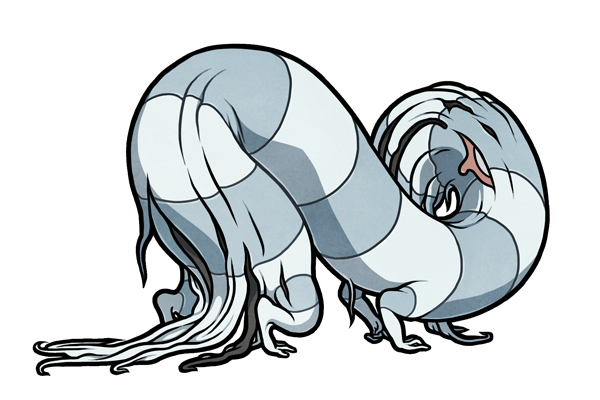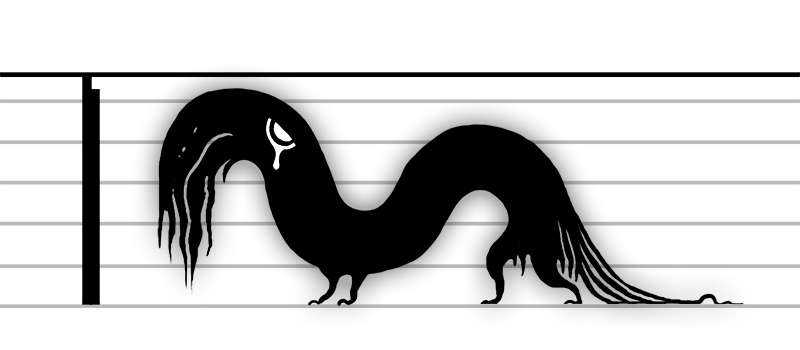

cevidroni
the victims
prefix cevi suffix droni
simulaes maerorus
physical appearance
The cevidroni /ˈsɛvədroʊni/ is a ragged stranger with sorrowful, pale-and-pink eye markings. Its supple skin is cold and clammy to the touch, and its insides are dark grey and highly waterlogged, with only a small cavity filled with soggy, charcoal-colored organs, stomach-like in form. Its hands and feet are small, and lack thumbs or claws. Because the cevidroni's flesh is so soft, its tail grows ragged and breaks apart early on in its life, leaving the stranger with long, scraggly ribbons of flesh that drag behind it. Its head has a similar tendency to break apart, giving the cevidroni its characteristic "shredded" appearance, its regenerative ability non-evident. It smells fetid, like a drowning victim's corpse, an odor that can easily be smelled from a distance, and which soaks into the cevidroni's surroundings.
The cevidroni's voice is quiet and shy, and is equally likely to sound masculine or feminine in pitch. It possesses no language, and instead communicates through a stifled stammer, as though struggling to but unable to get any other sound out.
Oh, oh. Ah-hh ah-ah, oh. Oh.

environment and generation
The cevidroni appears in houses that have been abandoned due to water, fire, or other structural damage. It strongly prefers peeling wallpaper, exposed wood, and burnt-out walls waterlogged from a firefighter's hose. Within these spaces, it grows from a soggy patch upon the ground, starting off as a drab-colored mass of mush, which raises and solidifies to form the cevidroni's limp, prone body. The cevidroni is exceptionally fragile during this time, and can be broken apart with one's bare hands. Its colors fade in just as it solidifies, its patterns spreading out across it like blooming mold, before the cevidroni raises its head and staggers to its feet with a timid stammer.
behaviour and effects
The cevidroni's personality is disconsolate and unresponsive. It tends to stay within a very small territory, with most cevidroni moving no more than fifteen feet from their point of generation. It is quietly destructive towards its surroundings, and rips apart papers, tears down wallpaper, and picks apart cardboard boxes into small scraps. It does not engage in these actions with malaise however, but rather, stares forward with a quiet daze, as though these actions are a distraction from a deeper trauma within itself.
The cevidroni displays respiratory movement, and emits the sound of breathing, although no breath can be felt in front of its mouth. As the cevidroni "breathes out," water appears in the walls, floor, and ceiling around it in a 5-16 foot radius. Each cevidroni produces a different amount of water, with some creating just enough to cause the walls around it to become damp and stained, while others can make a room so wet that it seems to rain indoors. Nonetheless, even a single cevidroni's presence tends to cause significant structural damage to its already-dilapidated surroundings as wood, carpeting, and remaining furniture grows warped and sodden.
The cevidroni displays few social behaviours, aside from the occasional glances at the dripping water produced by a nearby cevidroni. Conversations between individuals are half-hearted and brief in duration, with no direct physical interactions.
The cevidroni appears directly interested only in human corpses, and it stands over any body that it finds. With careful, mournful motions, it pushes strands of hair away from the corpse's face, strokes their cheeks, and placing its hands upon the corpse's own. It remains with these corpses until its own death, with water flowing like tears from its waterlogged face.
interactions with sensitives
Initially, the cevidroni displays indifference to sensitives, and looks at them from the corner of its eye, its posture submissive and unassuming. At its core, however, the cevidroni is a violent and aggressive stranger, and always attacks any sensitive who comes within five feet of them, raising up on its hind legs to hiss and claw with a vindictive distrust. Its body is so weak, however, that its frantic assault only causes its own skin to split and break apart, and it is incapable of doing harm to any human being. The cevidroni continues to swipe at the sensitive until the sensitive either backs off, or until the cevidroni is killed by its own assault.
Encounters with the cevidroni are linked to a fear of aging and disease. This effect occurs in 65% of sensitives, and sets in several months after the initial encounter. Afflicted individuals display intense anxiety at any signs of their own declining health or appearance, and, in addition, become incredibly distressed upon seeing any sign of decay in their environment. Individuals become incredibly stressed at a perceived inability to reverse the inevitable effects of entropy and decay, and often feel as though they are "rotting alive." Many sensitives are able to overcome this anxiety with either therapy, medication, or meditation, but still others fall either more and more into neurosis, or give up entirely, allowing their bodies and houses to fall apart due to lack of care and basic maintenance.
Two percent of sensitives touched by the cevidroni lose the ability to perceive moisture, a symptom which does not overlap with the aforementioned effect. Sensitives affected in this way feel nothing but a sensation of decreased temperature when passing their hand beneath cold water, for example, and feel thicker fluid (such as milk) as only a vague, vaporous sensation. Heavy fluids, like tar, are felt normally.
aging and death
As the cevidroni ages, it grows weaker and less active. A cevidroni at the end of its lifespan moves very little, instead preferring to lay dormant upon the ground, restricting itself to brief motions until it lacks the strength to even move at all. Its breathing slows, and the area around it grows dampened by one final exhalation, water trickling from the walls around it as its flesh becomes inert and grey. The cevidroni's flesh decomposes within several weeks, turning to a soft, oily liquid, which leaves behind a darkened stain on the floor beneath it.



